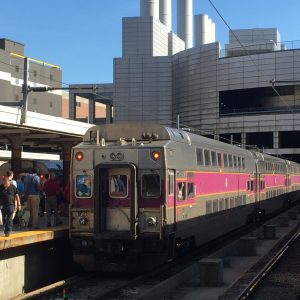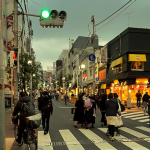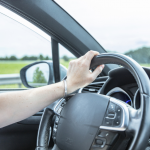New Jersey Future Blog
Supporting Equitable Access to Transit and Active Transportation
May 23rd, 2022 by Hannah Reynolds

Photo Credit: Emily Eckart
Content warning: This blog post contains discussion of sexual harassment and assault, especially as experienced by women and members of the LGBTQ+ community. If you or someone you know has experienced sexual violence of any kind, you can call 1-800-601-7200, a New Jersey statewide hotline for survivors of sexual violence, for support.
Creating opportunities for more people to walk, bike, and take public transit is a critical element of growing and developing smarter. As we improve infrastructure and programs to accomplish this goal, we must make sure that we are improving access for everyone, especially those who have traditionally been, and continue to be, excluded or made to feel less safe in these spaces.
Last year, a Philadelphia man sexually assaulted a woman on a SEPTA train, making national headlines. Just last month, another perpetrator of sexual violence on a SEPTA train was identified. Such threats to safety on public transit may seem like one-off incidents, unfortunate occurrences that were mostly due to being at “the wrong place at the wrong time.” However, violent crime, especially related to gender identity, is pervasive even closer to home. Across New Jersey in 2018, there were nearly 6,000 incidents of crime (excluding fare evasion) reported to NJ Transit Police, including 24 different forms of sex-based crime. As a result, public transportation emerges as a disproportionately dangerous space for female riders, resulting in inequitable utilization of transportation on the basis of sex and gender identity. In order to promote use of these affordable and sustainable modes of transit within cities and communities, it becomes imperative to ensure equitable access by actively acknowledging and addressing the disproportionate risk women face.
Indeed, women and members of the lesbian, gay, bisexual, transgender, and queer (LGBTQ+) communities face particularly high rates of harassment, violence, and inequity when it comes to use of public transit and other modes of transportation. Of the 63% of NYC public transit riders who report experiences of sexual harassment on the subway, 99% identify as female. Furthermore, in a survey of nonbinary and transgender individuals, 34% of respondents reported experiencing some form of discrimination or harm as a result of their gender presentation while using public transit. Clearly, for those who do not identify as cisgender men, harassment and discrimination in public spaces and public transportation becomes a commonplace risk that women, transgender, and nonbinary people are forced to live with. Through all of this, safety emerges as a major barrier to sustainable, affordable transportation within cities for women— especially those in the LGBTQ+ community— and transgender people of color, low-income individuals, and people with disabilities, among other marginalized community members.
In addition to the safety risks posed by public transit options such as trains, buses, and subways, street infrastructure can also contribute considerably to the danger experienced by women and gender-nonconforming people moving within and between communities. Simply existing as a woman or gender-nonconforming person in public spaces can lead to violence, injury, and even death. An estimated 65% of women have experienced street harassment in their lives; public spaces like sidewalks and buses are commonly the first place that teenage girls experience street harassment, from as young as middle-school age. In fact, teen girls have fewer safe, public spaces designed specifically for their use, as compared with their male peers, who often opt to hang out at skateparks, basketball courts, and other male-dominated spaces. In 2015, 14 women were attacked and murdered by men after rejecting their advances, demonstrating a detrimental disrespect for women’s space and comfort that is tacitly accepted in society. On a similar note, for women who opt to bike, one University of Minnesota study suggests that drivers are more likely to invade the space of female bikers than male bikers, demonstrating that even utilizing personal modes of transportation poses a greater risk of harm for women. As a result, it becomes clear that women and gender-nonconforming people are disproportionately discouraged from using public spaces and transit infrastructure. But even if women are at elevated risk when traveling by foot or public transit, these modes of transit offer opportunity for sustainable and affordable mobility within communities. In other words, in order to uphold use of these promising modes of transportation by all people of all backgrounds, efforts to enhance accessibility regardless of gender presentation must be a serious consideration.
Meanwhile, cost acts as another major barrier to access to affordable, efficient, and sustainable transportation options for women, transgender, and nonbinary people. As a result of these ever-present risks of harassment or assault on transit, many women and LGBTQ+ community members opt to take more expensive, inconvenient, and less environmentally friendly transportation options in order to avoid the risks of dangerous—albeit cheaper and more efficient—public transit. Similarly, low-income women are more likely to take public transit or walk to destinations than men and more affluent women, as many of these women lack the means to afford more expensive or less time-consuming transportation options. Low-income women are therefore at greater risk of experiencing physical or sexual violence in these spaces. At the same time, women who live further from urban centers, especially in rural and suburban communities, may find that public transit options are limited, expensive, and inconvenient. Consequently, inequitable access to public transportation becomes not only a matter of gender equity, but an issue of socioeconomic and geographic relevance.
In seeking solutions to make safer, more accessible, and more sustainable public transportation and spaces for women and non-cisgender people, we should prioritize solutions that also make these spaces safer for other traditionally marginalized groups. Especially as our country undergoes a national reckoning in terms of race and police accountability, solutions for equitable transportation options must consider which solutions are most just, equitable, and safe for all women and gender-nonconforming individuals, including people of color, queer people, people with disabilities, and unhoused peoples. In an interview from The Gender Policy report, a person named Janelle demonstrated the importance of considering multiple demographic and social factors in efforts at keeping women and gender-nonconforming people safe, explaining, “I do not feel safe with any police officers, ever. I don’t trust the police, just based on my personal history with them, but also being Black and trans and queer and disabled.”
While perhaps more surveillance will not be effective in decreasing crime or increasing perceptions of safety, as indicated by such concerns around policing, opportunities for sustainable, equitable, safe communities for women and gender-nonconforming people emerge in terms of infrastructure. Within public spaces, the establishment of wider sidewalks and better lit streets, more green spaces, well-maintained parks, enforced speed limits, and dedicated bike lanes (perhaps with a buffer of parked cars to protect bikers) and other transportation infrastructure can help facilitate safe, affordable, and sustainable transportation options for women, such as biking and walking. Creating walkable and bikeable cities has the potential to prevent up to 23 gigatons of carbon dioxide from being emitted in the U.S. alone by midcentury. Furthermore, by creating public transit schedules that accommodate the schedules of care workers and offering transit options that are accessible for older adults and young children in strollers, caregivers—who are predominantly women—can more easily access forms of public transit that are presently designed around the needs of working men. Altogether, the establishment of reliable, affordable, safe, and accessible infrastructure has the opportunity to not only promote gender equity within communities, but also to implement more sustainable modes of travel for the future.
Perhaps most importantly, in order to ensure that women, transgender, and nonbinary people can both access and feel safe in their use of public spaces and transit options, it is crucial to actively solicit their perspectives throughout public planning efforts. In considering areas for investment, such as biking infrastructure, it is important to consider not only where there are the biggest risks for safety, but also who opts not to use such infrastructure due to danger or inaccessibility, especially women and other historically and presently excluded populations. Currently, there is a lack of female, transgender, and nonbinary representation throughout public planning efforts, despite their unique lived experiences related to safety, fear, and inaccessibility of public spaces and transportation. Moving forward, it is crucial to prioritize representation of women and gender-nonconforming people within conversations about public planning and transportation infrastructure, rather than keeping public transit as it is: designed for men, by men. By adapting the planning and design of our communities to the concerns of those who face the most risk, our communities become safer and more accessible for everyone, improving the quality of transit options for all people.
Related Posts
Tags: bike, equity, Transit, Transportation, walk
















